by California Casualty | Educators |
Digital Literacy
Our students know technology. They’ve used it their entire lives. However, just because they can operate and use digital devices such as smart phones, tablets, and video games, doesn’t mean they are digitally literate. Students, no matter how digitally experienced they may seem, should understand safety risks and best practices. A digitally literate student should be able to:
- Understand and use computing devices and networks
- Behave responsibly while engaged in social networks and other online communities
- Locate, evaluate, share, and create content using information, images, and data found online
- Think critically, particularly about how technology may contribute to social issues
- Communicate respectfully and purposefully
- Utilize above skills in real-world situations
Online Etiquette
When speaking with someone face-to-face or on the phone, we tend to err on the side of politeness and respectfulness. So, wouldn’t the same go for communicating with others online? Teaching students online “manners” will help students to become responsible digital citizens.
Here are 10 guidelines for being polite online:
- Check Before You Send – Are there blatant misspellings or grammar mistakes? Could someone misinterpret what was written? Is the message hurtful? If you answered yes to any of these questions, please don’t send your message.
- Don’t Get Involved In Anything Negative – If a conversation begins to turn negative, politely remove yourself. If you start to become upset, you don’t want to send something you’ll later regret.
- Respect Others and Their Opinions – Even if your view differs from someone else’s, it is important to respect their opinion.
- Be Precise – Communicate clearly, purposefully, and get to your point quickly.
- Know Your Audience – Abbreviations, acronyms, and emoticons are fine when communicating with friends, but are not appropriate when communicating formally with someone.
- Avoid All Caps – All capital letters makes it seem like you are shouting.
- Ask Permission Before Posting Anything About Your Friends – You may embarrass your friend or get them in trouble.
- Try To Avoid Humor and Sarcasm – Picking up on humor and sarcasm without seeing the sender’s facial expressions and body language can be difficult. It may cause confusion and hurt feelings.
- Don’t Over Share – Don’t share more than is necessary. If you wouldn’t share it in real life with your classmates, teachers, or family members, then it’s probably not okay to share online.
- Be Kind and Positive – this one is self-explanatory!
Learning to be good digital citizens will prepare our students for life in the “real world.” By becoming digitally literate and practicing online etiquette, students will learn to survive and succeed in an ever-changing, internet-dominated society.
Resources
digitalliteracy.us – a teacher-created website helping educators teach students best and safe practices as they use the Internet and record their digital footprint.
digitalliteracy.gov – the Digital Literacy portal organizes content conveniently, enables valuable discussion and collaboration among users and elevates best practices to improve the quality of digital literacy offerings.
ThinkB4U – provides teachers with videos, resources, and other sources for the classroom.
Interland – Interland is an adventure-packed game that lets kids put fundamental lessons of digital safety into practice to help them ‘Be Internet Awesome’.
Digizen – Internet Social Networking advice and guidance for young people, parents and teachers.
InCtrl – Learn how to be safe and secure and how to make smart choices to remain InCtrl of your digital reputation!
Teacher’s Guide to Digital Citizenship – a brief introduction to Digital Citizenship for teachers by Edudemic.com
CyberWise – Learn about digital citizenship, Internet safety, security, privacy, sexting, cyberbullying, reputation management and more so you can help kids embrace technology safely and wisely.
Digital Passport – The interactive, fun, and effective way to teach and test the basics of digital citizenship to 3rd-5th grade.
by California Casualty | Educators |
California Casualty is proud to join the NEA Foundation in congratulating the recipients of one of public education’s most prestigious awards: the 2018 California Casualty Awards for Teaching Excellence.
Exceptional teachers make a difference for their students. To recognize some of them, the NEA Foundation recently announced the 2018 California Casualty Awards for Teaching Excellence recipients.
The 38 awardees represent the best of their profession and will be honored at the NEA Foundation’s Salute to Excellence in Education Gala next February in Washington, D. C.
The California Casualty Awards for Teaching Excellence are unique: in addition to exhibiting excellence in instructional and professional practice, awardees are nominated by their peers – their NEA state affiliate – for their dedication to the profession, community engagement, professional development, attention to diversity, and advocacy for fellow educators.
Their passion is reflected by their teaching philosophies. “Teaching makes all other professions possible. We are molding the next generation that will lead us through change and navigate the complexities of modern life,” said one.
“Every student in my classroom is encouraged to be comfortable in the skin he or she is in, which helps to create an environment that is conducive to learning,” said another.
And one instructor remarked, “Students who are going through any sort of issue know that they can come to my room for a break. I do not force them to talk to me, but I do make it known that I am there to listen and help if needed.”
Each year, the Salute to Excellence in Education Gala draws almost 1,000 supporters of public education, and thousands more online, to applaud these awardees. At the gala, the educators are truly the stars, celebrated throughout the night with music, performances, videos, and more. The evening gives educators well-deserved recognition for their hard work, personal dedication, and profound influence.
“These outstanding educators put heart and soul into supporting students and improving the profession,” said Harriet Sanford, NEA Foundation President and CEO. “We deeply appreciate California Casualty’s partnership in recognizing educators across the country.”
“We are glad to have the chance to show our respect and appreciation for the work of public school educators each year,” said Beau Brown, California Casualty CEO. “We applaud the great work of the California Casualty awardees.”
Each California Casualty Award for Teaching Excellence awardee’s school will receive a $650 award. California Casualty provides financial support for the awards and Field Marketing Managers will help make local presentations in August, September and October.
During the NEA Foundation’s Salute to Excellence in Education Gala on February 9, 2018 in Washington, D.C., the nation’s top educator will be revealed. The gala will be livestreamed at www.neafoundation.org.
The NEA Foundation and the National Education Association jointly present the awards.
Find more information about the awards and photos of the awardees at https://www.neafoundation.org/pages/nea-awardees.
ABOUT THE NEA FOUNDATION
The NEA Foundation is a public charity founded by educators for educators to improve public education for all students. Since our beginning in 1969, the Foundation has served as a laboratory of learning, offering funding and other resources to public school educators, their schools, and districts to solve complex teaching and learning challenges. We elevate and share educator solutions to ensure greater reach and impact on student learning. We believe that when educators unleash their own power, ideas, and voices, communities, schools, and students all benefit. Visit neafoundation.org for more information.
by California Casualty | Educators |
Are your students truly engaged during your instruction? Getting, and keeping, students academically engaged may be one of the most difficult aspects of teaching. Classroom technology can help.
The International Society for Technology in Education (ISTE) says the number one way to increase student engagement is to reach them through technology. “By integrating technology in the classroom, educators can take learning experiences to the next level and significantly improve student performance.”
Increase student engagement in your classroom using some of these simple, online engagement tools in your next lesson.
EDPuzzle – the easiest way to engage your students with video. Pick a video, add your magical touch and track your students’ understanding
Flippity – allows users to easily turn a Google Spreadsheet into a set of online flashcards, MadLibs, game show, and other cool stuff.
Kahoot! – a free game-based learning platform that makes it fun to learn – any subject, in any language, on any device, for all ages!
Safe YouTube – Watch, crop and share safe YouTube videos without comments, ads, or other distractions. Videos can be integrated with Google Classroom or downloaded as an .MP4 file.
QuotesCover– Create beautiful visual quotes as images. Download and share on your favorite social network.
ClipGrab – ClipGrab is a free downloader and converter for YouTube, Vimeo, Metacafe and many other online video sites. Save the video file to your drive and upload to your classroom site to share with students.
Dotstorming – Dotstorming allows users to create a space for people to post digital sticky notes. Those notes can contain text and or images. Dotstorming takes the process of dot voting online to allow groups of people to collaborate on a topic.
Plickers – Plickers is a powerfully simple tool that lets teachers collect real-time formative assessment data without the need for student devices.
Do you have any web tools you use to enhance student engagement in your classroom? We’d love to hear about them! Please share your thoughts and suggestions in the comments below.
This article is furnished by California Casualty. We specialize in protecting Education Professionals with auto and home or renters insurance tailored to your life. To learn more about our exclusive benefits and discounted rates, call 1-866-704-8614 or click here.
by California Casualty | Educators |
A recent study conducted by Stanford University “shows a dismaying inability by students to reason about information they see on the Internet.” Plain and simple, our students cannot determine fact from fiction when it comes to online content. When conducting research for assignments and projects, it’s important that students learn to separate what is fabricated from what is credible.
Educators should be at the forefront of this “battle” against false information. We must teach our students to be critical of everything they read online and encourage them to take the time to verify what they find. It’s not as hard as it sounds. The following ideas, tips, and resources may help you teach your students how to be informed, discriminating consumers of online media.
Questions to ask when consuming a piece of media:
- Who made this? Did a well-known or common source create it?
- Does it make sense?
- Does the information match with other reliable sources?
- Who wrote it?
- When was it written?
- Who is the intended audience?
- Who paid for it? If you click on it, does someone get paid?
- Are important details left out of the message?
Items that may indicate a piece of media is fake (commonsensemedia.org):
- look for unusual URLs or site names, including those that end with “.co” — these are often trying to appear like legitimate news sites, but they aren’t.
- Look for signs of low quality, such as words in all caps, headlines with glaring grammatical errors, bold claims with no sources, and sensationalist images (women in bikinis are popular clickbait on fake news sites). These are clues that you should be skeptical of the source.
- Check a site’s “About Us” section. Find out who supports the site or who is associated with it. If this information doesn’t exist — and if the site requires that you register before you can learn anything about its backers — you have to wonder why they aren’t being transparent.
- Check Snopes, Wikipedia, and Google before trusting or sharing news that seems too good (or bad) to be true.
- Consider whether other credible, mainstream news outlets are reporting the same news. If they’re not, it doesn’t mean it’s not true, but it does mean you should dig deeper.
- Check your emotions. Clickbait and fake news strive for extreme reactions. If the news you’re reading makes you really angry or super smug, it could be a sign that you’re being played. Check multiple sources before trusting.
Games
Factitious – a game that tests your news sense.
Fact-Checking Websites
Snopes.com
FactCheck.org
Politifact.com
Lesson Plans
Channel One News – A lesson plan explores the problem of fake news sites, featuring a Channel One News video about the issue.
PBS Newshour – Fake news is making news, and it’s a problem. This lesson gives students media literacy skills they need to navigate the media, including how to spot fake news.
Corwin Connect – Guide students through meaningful discussions on the concepts of truth, media manipulation, falsification, public opinion, and more. (PDF Version)
TED-Ed – Damon Brown gives the inside scoop on how the opinions and facts (and sometimes non-facts) make their way into the news and how the smart reader can tell them apart.
ReadWriteThink – Hoax or No Hoax? Strategies for Online Comprehension and Evaluation.
CoolCatTeacher – 3 fast, free lesson plans to fight fake news
Sites With Fake Media (for learning purposes)
The Tree Octopus – An internet hoax created in 1998, the website fabricates information about the endangered Pacific Northwest Tree Octopus and what you can do to save it. The website is now used to teach students about internet literacy.
All About Explorers – All About Explorers has a series of lessons for elementary age students in which they can learn that just because it is out there for the searching does not mean it is worthwhile.
by California Casualty | Educators |
Our Education Blogger is a public school teacher with over a decade of experience. She’s an active NEA member and enjoys writing about her experiences in the classroom.
Organize your classroom on a budget. From labeling to sorting supplies, this list of must-have, inexpensive classroom organization hacks will help get your school year off to a great start and keep it tidy all year:
Colorful Plastic Caddies
Plastic caddies have multiple uses in the classroom. Place materials in them for easy science experiment or art station set up. If your students sit in groups, use the caddies to store necessary, daily utensils and supplies. Use them for art supply storage, math manipulative storage, or to simply organize your desk. I purchased my caddies from Target in the dollar bins ($3 each). I have also seen them at various dollar stores.
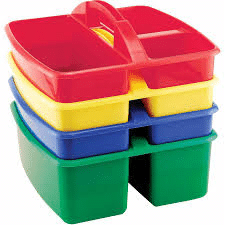
Milk Crates
Milk crates are a perfect fit for folders and files. I use one of my crates to store Student Data Folders when we are not recording in them. When I need to lug around supplies, I tend to use a milk crate. When topped with a homemade cushion, milk crates make great seats and benches (see Pinterest for millk crate seat ideas and tutorials). Stack them for use a classroom library (ziptie each crate together for stability and don’t overfill). I found some durable milk crates on sale at Target when all of the college dorm items go on sale.
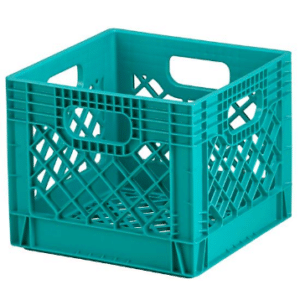
Binders
Binders are great way to organize just about anything paper-related. Use them to file away your master copies, one binder for each subject or hour you teach. A substitute binder makes preparing for your absences a cinch. Archive student work in student portfolio binders. Store absent work and extra copies in a classroom binder for students to access as needed. Binders also make tracking student data simple. Label your binders with these free, editable, printable binder covers and spines from Curriculum Corner. 
Labels, Labels, and More Labels!
This will help you and your students locate supplies and materials around the classroom in a jiffy! In my experience, if it is labeled, I’m more likely to use it; I simply forget it’s there! I found several free, editable, printable labels on TeachersPayTeachers.
Polka Dot Labels
Black and White Chevron Labels
Rainbow Mixed Design Labels
Brights and Black Labels
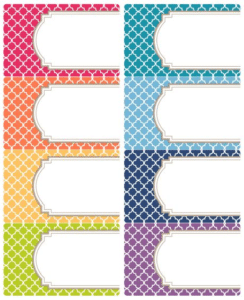
Plastic Drawers
While plastic drawers aren’t inexpensive, you’ll see them as a savvy investment down the road. I purchased 4, 3-drawer units and will never go back to my previous method of organization. Label the drawers with each day of the week and place your lessons, materials, and other items for the day inside. Set aside drawers to label as “To Copy” and “To Grade” to help organize your piles of papers. I also use one drawer as the “Emergency” lesson plan drawer in case of an unexpected absence. Plastic drawers are helpful in storing and organizing manipulatives, art supplies, extra work, absent work, and copies for future lessons/units. Don’t forget to label your drawers!
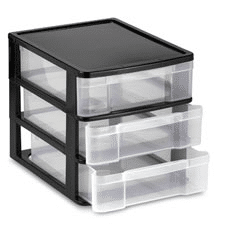
Shoebox-sized Clear Bins
This one is a no-brainer. I never seem to have enough of these around. Small, plastic bins are one of the most versatile organization items in the classroom. Use them to store extra supplies, manipulatives, craft items, and games. Use labels to help identify what’s inside. They are easy to stack and easy for even the youngest of students to access. Dollar stores usually have these, but they aren’t great quality. I go for Sterilite and Rubbermaid brands when I can get them on sale. I also ask for these from parents in my Teacher Wish List at the beginning of the school year.
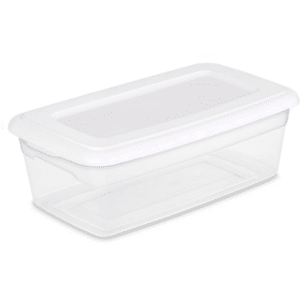
What are your favorite tricks to organize your classroom on a budget?
This article is furnished by California Casualty, providing auto and home insurance to educators, law enforcement officers, firefighters and nurses. Get a quote at 1.866.704.8614 or www.calcas.com.
by California Casualty | Educators |
Don’t have the hands-on materials you need to teach science? Don’t worry, you’re not alone. Many districts and schools lack the funding to furnish science textbooks, materials, and equipment. There is a solution. These websites can help you teach science interactively using games, videos, experiments, and other student-friendly activities for FREE. They are an engaging supplement to your classroom instruction. So, reserve that computer lab, sign up for those tablets, and get science-ing!
Science Kids – Enjoy free activities, experiments, games, facts, quizzes, projects, lessons, images, and videos. Students can learn about animals, biology, chemistry, physics, space, weather, and mcuh more.
SheppardSoftware – Free activities and games for younger students. Topics include life cycles, animals, the seasons, dinosaurs, elements, chemistry, cells, and many more.
PBSKids Science Games – For the youngest of our gradeschool students. PBSKids Science Games uses popular PBS characters, like Dinosaur Train, Sid the Science Kid, and the Cat in the Hat, to help teach young students about dinosaurs, nature, engineering, and animals.
Bozeman Science – This collection of videos and other NGSS resources helps teachers and students better understand the Next Generation Science Standards. Search by grade level, standard, or disciplinary core idea.
Coolmath-Games (Science) – Don’t let the website name deceive you. This small collection of free kids science games cover topics like space, electricity, light, physics, and magnets.
Kids.gov – In addition to a library of videos on many subjects, Kids.gov has an assortment of science games intended for a middle school level audience. Students, grades 6-8, can enjoy science games within the topics of animals, energy, earth, environment, invention, innovation, and space games.
Learning Games for Kids – At Learning Games for Kids, younger students can conduct science experiment games, sing science songs, amd play space and weather games.
NASA Space Place – Students of all ages will flip for these space-related games. Topics include Earth, Sun, Solar System, Universe, and Science and Tech.
Mystery Science – Free teacher memberships through June 2018! Mystery Science is aligned to the Next Generation Science Standards. No prep lessons with visuals and activities for K-5th grade.
NOVA Labs – Experience the science occurring in the Evolution, Cybersecurity, RNA, Cloud, Energy, and Sun labs that provide meaningful, interactive tasks for students to complete. Students can also watch video clips on each subject. NOVA Labs is geared toward students in grades 6-12.
PhET Interactive Simulations – Free, meaningful lab experiences for physics, chemistry, biology, Earth science, and math. PhET covers a wide range of topics and grade levels.
Mr. Nussbaum – Mr. Nussbaum’s Science includes a large collection of science interactives, explanations, generators, and activities for students. The wide variety of topics is intended for students in elementary and middle school.
Turtle Diary – Turtle Diary’s science games are sure to spark the curiosity in students preschool through 5th grade. Students can explore early science concepts covering a wide range of topics while reinforcing skills through engaging activities.






